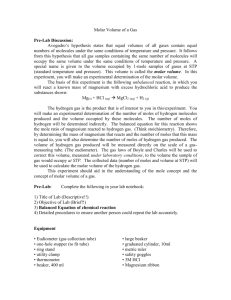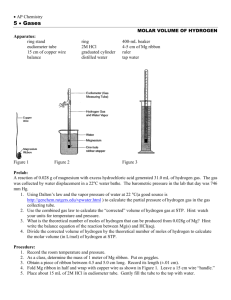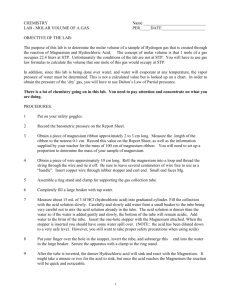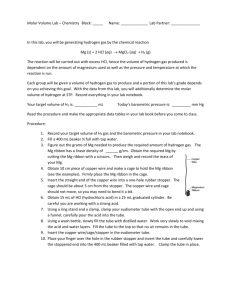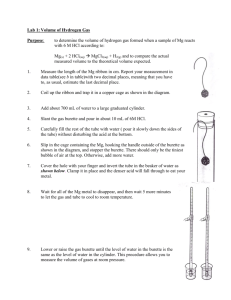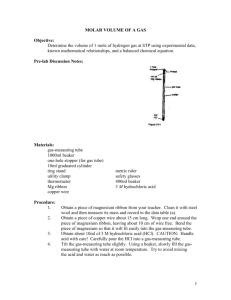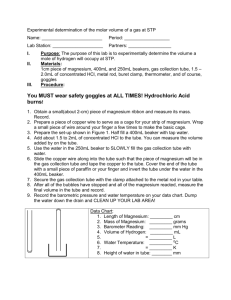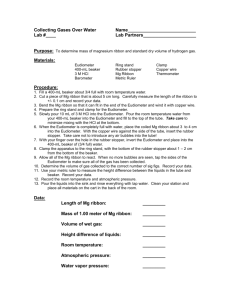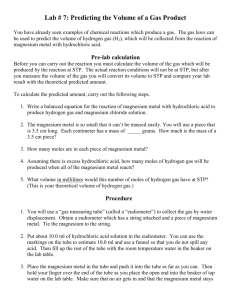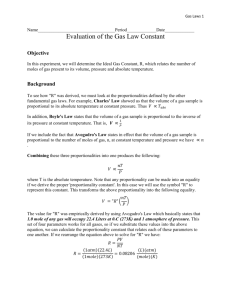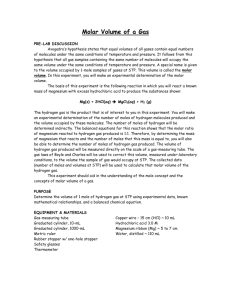Honors Chem: Molar Volume of Hydrogen Gas
advertisement
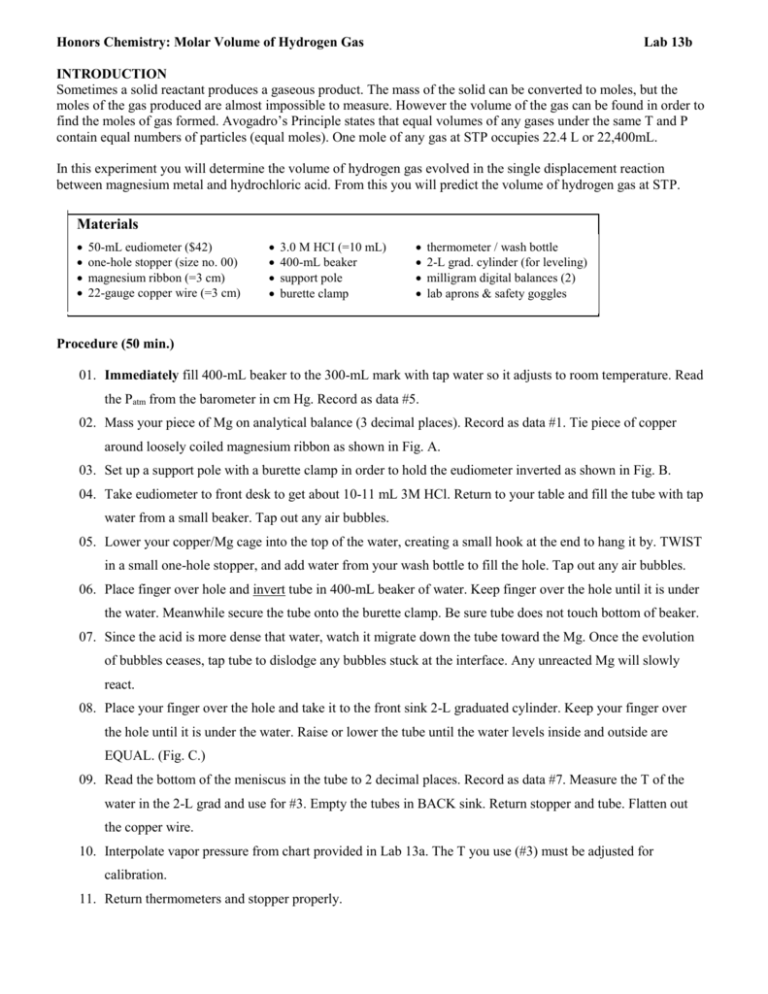
Honors Chemistry: Molar Volume of Hydrogen Gas Lab 13b INTRODUCTION Sometimes a solid reactant produces a gaseous product. The mass of the solid can be converted to moles, but the moles of the gas produced are almost impossible to measure. However the volume of the gas can be found in order to find the moles of gas formed. Avogadro’s Principle states that equal volumes of any gases under the same T and P contain equal numbers of particles (equal moles). One mole of any gas at STP occupies 22.4 L or 22,400mL. In this experiment you will determine the volume of hydrogen gas evolved in the single displacement reaction between magnesium metal and hydrochloric acid. From this you will predict the volume of hydrogen gas at STP. Materials 50-mL eudiometer ($42) one-hole stopper (size no. 00) magnesium ribbon (=3 cm) 22-gauge copper wire (=3 cm) 3.0 M HCI (=10 mL) 400-mL beaker support pole burette clamp thermometer / wash bottle 2-L grad. cylinder (for leveling) milligram digital balances (2) lab aprons & safety goggles Procedure (50 min.) 01. Immediately fill 400-mL beaker to the 300-mL mark with tap water so it adjusts to room temperature. Read the Patm from the barometer in cm Hg. Record as data #5. 02. Mass your piece of Mg on analytical balance (3 decimal places). Record as data #1. Tie piece of copper around loosely coiled magnesium ribbon as shown in Fig. A. 03. Set up a support pole with a burette clamp in order to hold the eudiometer inverted as shown in Fig. B. 04. Take eudiometer to front desk to get about 10-11 mL 3M HCl. Return to your table and fill the tube with tap water from a small beaker. Tap out any air bubbles. 05. Lower your copper/Mg cage into the top of the water, creating a small hook at the end to hang it by. TWIST in a small one-hole stopper, and add water from your wash bottle to fill the hole. Tap out any air bubbles. 06. Place finger over hole and invert tube in 400-mL beaker of water. Keep finger over the hole until it is under the water. Meanwhile secure the tube onto the burette clamp. Be sure tube does not touch bottom of beaker. 07. Since the acid is more dense that water, watch it migrate down the tube toward the Mg. Once the evolution of bubbles ceases, tap tube to dislodge any bubbles stuck at the interface. Any unreacted Mg will slowly react. 08. Place your finger over the hole and take it to the front sink 2-L graduated cylinder. Keep your finger over the hole until it is under the water. Raise or lower the tube until the water levels inside and outside are EQUAL. (Fig. C.) 09. Read the bottom of the meniscus in the tube to 2 decimal places. Record as data #7. Measure the T of the water in the 2-L grad and use for #3. Empty the tubes in BACK sink. Return stopper and tube. Flatten out the copper wire. 10. Interpolate vapor pressure from chart provided in Lab 13a. The T you use (#3) must be adjusted for calibration. 11. Return thermometers and stopper properly. Technique Hints 01. Leave a 1-cm gap between the top of the stopper and the bottom on the beaker in step 6. 02. The 3 M HCl causes burns, so avoid skin contact. Rinse hands well if you touch any, and tell the teacher. 03. The eudiometer is very expensive, so handle it carefully. ANALYSIS 01. Prepare a data chart like this one shown below: 01. 02. 03. 04. 05. 06. 07. 08. 09. 10. 11. Description Mass of Mg ribbon (g) Moles of Mg reacted (mole) Adjusted water temperature, T (°C) Adjusted water temperature, T (K) Atmospheric pressure, (cm Hg) Atmospheric pressure (kPa) Total volume of wet gas collected, V (mL) Vapor pressure (v.p.) of water in #3 (kPa) Pressure of dry hydrogen gas, P (kPA) Volume of dry hydrogen gas STP (mL) Volume of dry hydrogen gas STP per mole of Mg reacted (mL) Measurement CALCULATIONS 01. Your EIGHT calculations (underlined above) must follow your sample lab for credit. 02. Calculation #3 requires you to calibrate your thermometer from your Lab 13 a boiling water bath. For example, if your thermometer read 94.0°C (instead of 100.0°C), it is 6.0% low. Thus your reading made today must be multiplied by (100.0/94.0) to correct for the error. The ratio in parentheses is called the “adjustment multiplier”. 03. Calculation #4 is made by adding 273.16 to your °C temperature. Follow SF rule for this addition. 04. Calculation #9 = #6 - #8. Interpolate the water vapor pressure from the chart in Lab 13a to find #8. 05. Calculation # 10 uses the combined gas law, (P1V1)/T1 = (P2V2)/T2 , to convert your original volume in #7 to the gas volume at STP conditions CONCLUSIONS 01. 02. 03. 04. Write the balanced equation for this reaction, including all phases. Hypothetically, if you reacted “x” moles of Mg, how many liters of hydrogen gas would form at STP? Identify the limiting and excess reactants in this lab by giving their chemical names. Compare your experimental value of the molar volume to the theoretical value at STP by showing the calculation for your percent error. Show all work and sig. figs. 05. Why doesn’t the copper wire react with the HCl?
